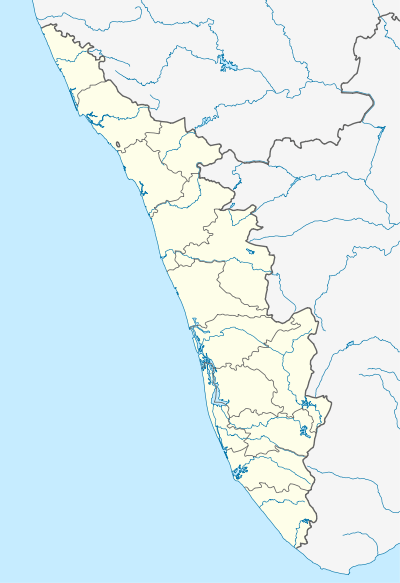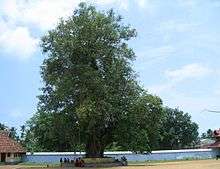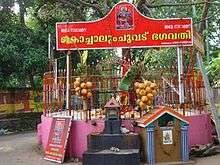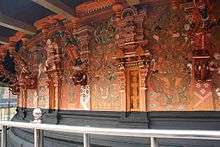Vaikom Temple
| Vaikom Mahadeva Temple | |
|---|---|
|
Vaikom Mahadeva Temple | |
 Vaikom Mahadeva Temple Location within Kerala | |
| Name | |
| Malayalam | വൈക്കം മഹാദേവ ക്ഷേത്രം |
| Geography | |
| Coordinates | 9°46′0″N 76°24′0″E / 9.76667°N 76.40000°ECoordinates: 9°46′0″N 76°24′0″E / 9.76667°N 76.40000°E |
| Country | India |
| State | Kerala |
| District | Kottayam |
| Location | Vaikom |
| Culture | |
| Primary deity | Shiva |
| Important festivals | Vaikom Ashtami |
| Architecture | |
| Architectural styles | Traditional Kerala style |
| History and governance | |
| Temple board | Travancore Devaswom Board |
| Website | vaikomtemple.org |
The Vaikom Mahadeva Temple is a temple for the Hindu god Shiva in Vaikom, Kerala. The temple, along with Ettumanoor Siva Temple, Kaduthuruthy Thaliyil Mahadeva Temple is considered a powerful trisome. The belief is that if a devotee worships at these three temples before 'Ucha pooja', all the wishes are fulfilled.
The Vaikom Mahadeva temple is one of the few temples which is held in reverence by both Shaivaites and the Vaishnavaites. Vaikom’s Shiva is fondly called Vaikkathappan. The Shiva Linga here is believed to be from the ‘Treta yuga’ and considered as one of the oldest temples in Kerala where pooja has not been broken since inception.

The temple is one of the major Shiva temples in Kerala counted along with the Ettumanoor Mahadevar Temple, Kaduthruthy Mahadeva Temple, Chengannur Mahadeva Temple, Ernakulam Shiva Temple and Vadakkunathan temple.[1]
Pre-Colonial history
Kharasura on receiving the Shaiva Vidya Upadesh from Malyavan went to Chidambaram, and did severe penance and Tapasya for the attainment of Moksha. Pleased with his penance Lord Siva granted all the boons he asked, and presented him with three great Siva Lingas drawn out of Him. Assuring that He will ever be present in them, Lord Siva disappeared, asking Khara to worship the Lingas to attain Moksha. When Khara was returning south from Himalayas with the three Lingas, one in his right hand, one in left hand and other by the neck, he felt tired and rested awhile. After rest when he tried to pick up the lingas, they wouldn’t budge. He realized that it was Shiva’s maya and when called unto, the heavens spoke thus, “I shall remain here giving Moksha to whom so ever * take refuge in Me”. Khara having attained Moksha entrusted the holy Lingas to the custody of Maharshi Vyaghrapada who had followed him invisibly and asked the sage to protect and worship them.
Myths & Beliefs

Belief is that the Siva Linga placed by Khara Asura by his right hand is being worshipped at Vaikom, the one in left hand at Ettumannoor and the one by neck at Kaduthuruthy even to this day.
The Linga carried by Khara with his neck is believed to be at Kadathuruthy and the one by his left hand is at Ettumanoor. The fact that the distance from Vaikom to Kadathuruthy and from there to Ettumanoor is more or less the same, gives credence to this legend. So the Darsana of all these three Lingas on a same day is considered as good as the Siva Darsana at Kailas – the Abode of the Lord.
On a *Vritchika - Krishna paksha – Ashtami dahy (According to Malayalam Era), the Lord of Lords and God of Gods - Siva the Paremeswara appeared to the Maharshi with his consort Parvati - the Jagat Janani. The Lord proclaimed, “This place shall be known as Vyaghrapadapurma”, and disappeared. The world famous Vaikkathashtami and all connected holy festivals are observed here even to this day on the same Vrichika – Krishna*- Ashtami.

Vyaghrapada Maharshi continued the Pooja in most esteem and devotion for some time and went on pilgrimage.Months and years passed. Sri Parasurama – the Chiramjeevi was going by the sky one day. Seeing good omens alighted here and saw a Holy Siva Linga emerged in water emitting heavenly rays. He could understand that it was the Siva Linga placed by Khara. Sri Parasurama thought himself that, the holiest and noblest Siva Chaitanya could be a great refuge for the devoted who wish to attain Moksha. He consecrated the auspicious Linga here with His earnest Prayers and recitation of Siva Manthras.
The most benign Lord Siva at once appeared with his consort Parvati Devi before Parasurama. He was so pleased that the Linga was consecrated with the Manthras by Parasurama – an avatar of Vishnu, his greatest devotee. The kind Lord Siva said to Parasurama, “From now onwards I shall stay here as Shaiva-Vaishnava Chaithanya granting all blisses and Moksha to all devotees”.
Full of joy and gratitude Parasurama performed Siva Linga pooja there for some days. Then he himself built a temple here and entrusted a noble Brahmin of Taruna village whom he taught Pooja Manthras. The Brahmin had learned all the 28 Sivagama and wore rudraksha and bhasma. Parasurama donated the whole temple with Linga to Brahmins and disappeared.It is the belief that the temple and all rites and customs are planned and fixed by Parasurama himself.
It is believed that the ‘Vyaghralayesha’ Siva gives His Blessings to the Devotees in three Bhavas or forms in the morning, noon, and evening in this Holy Temple. As Dhakshinamoorthy in the morning time, Kirathamoorthi in the noon time & Shakti Panchakshari in the evening.
The closed door
The Vaikom Temple was in the ownership of one hundred and eight families in olden days. The owners were divided into two groups and one group joined the ruler’s side. Their disputes and quarrels increased day by day. One day a section of the divided group came to the temple at noon. The chief among them a certain Njallal Namboothiri was prepared to stop the pooja in the noon. At that time the Nivedya was used to be placed in the western side of the Namaskara Mandapa. There was an entrance in the western courtyard. The Njallal Namboothiri after keeping his apron (Randam Mundu) above the western door came near the Nivedyas and spat the remains of his betel chewing on the Nivedya. So the pooja was disrupted. On return, while he was taking his apron from the door top it is stated that a highly poisonous snake bit him to death. He crawled himself outside the west and died. The Western door of the temple courtyard automatically closed itself then and a voice was heard from inside the Sreekovil thus “This door should not be opened any more”. The door remains closed to this day to show the wrath of the Great Lord against the disruption of His poojas
Architecture

One of the bigger temples in Kerala, the Vaikom Mahadeva Temple has a courtyard of about eight acres of land. The premises levelled with river sand is protected by compound walls with four Gopuras or towers on all the four sides. The Sreekovil is round in shape roofed with copper sheets and with two chambers. The Mukha Mandapa - the first chamber is built in shaped stone and single piece woods. The walls and pillars are very strong. The Garbha Griha(Sanctum Santorium) – the second chamber is built completely in stone including the roof in a square shape.It is a very curious and peculiar fact that we are unable to obtain the Darsana of the Supreme Saiva Chaitanya from this Sreekovil without passing through a 'six steps' either from the Gopura or the Nada. It may be reminding us the Shad (six) vikaras (emotions) such as Kama, Krodha, Lobha, Moha, Madha and Mathsarya or the thantrik chakras as per the thanthrik Kalpana.
Vaikom Ashtami
The Vaikom temple is famous for the Vaikom Ashtami (Vaikathashtami), one of its main festivals, which is held in November–December. The exact date of the festival is determined by the Malayalam calendar.
Vaikathashtami is celebrated on the day of Krishna Ashtami. The legend behind this festival is that years ago a saint man named Vyaghrapada prayed to God siva for years after many years God siva and his wife Parvathy Devi appeared in front of him. It is believed that god Siva appeared in front of him in the day of Krishna Ashtami. So as a memory of this Vaikathashtami is celebrated. It is the festival extending for 12 days. 12th day is Vaikathashtami.
Picture gallery
 Decorated Rishabhavahanam
Decorated Rishabhavahanam Temple pond
Temple pond Vyakhrapada Sanketham
Vyakhrapada Sanketham- Padinjare nada (west gate)
 Mural paintings in the temple
Mural paintings in the temple
References
- ↑ "Kerala Siva Temples". Hinduism Today. 31 July 1997. Retrieved 5 August 2015 – via HighBeam Research. (subscription required (help)).
http://www.vaikomtemple.org/Default.aspx
External links
| Wikimedia Commons has media related to Vaikom Temple. |